Shreya Ghoshal requests youth to embrace Indian ragas
MUMBAI: Shreya Ghoshal, who’s songs have touched the hearts of people across the world, feels Indian youth are negligent towards Hindustani classical music. The singer shared her opinion on her Twitter handle.
Expressing her views, Shreya tweeted , “I feel most of our current generation is ignorant from the fact what impact Indian ragas can have on anybody’s heart if played or sung with all soul.”
The Kar Har Maidaan Fateh singer didn’t stop here but went on to request youngsters to give this precious Indian musical heritage a chance.
“Open your hearts to real Indian music. Give it a try may be, when you’re a li’l emotionally vulnerable you will be less in denial, “she further mentioned in her tweet.
Well, Shreya is completely true as Indian ragas not only leave a footprint on our hearts but also colours our mind. And we hope that Indian youth tune into classical numbers after listening to Ghoshal’s plea.
Raga
A raga or raag (IAST: rāga; also raaga or ragam; literally “coloring, tingeing, dyeing”) is a melodic framework for improvisation akin to a melodic mode in Indian classical music. While the rāga is a remarkable and central feature of the classical Indian music tradition, it has no direct translation to concepts in the classical European music tradition. Each rāga is an array of melodic structures with musical motifs, considered in the Indian tradition to have the ability to “colour the mind” and affect the emotions of the audience.
Each rāga provides the musician with a musical framework within which to improvise. The specific notes within a rāga can be reordered and improvised by the musician. Rāgas range from small rāgas like Bahar and Shahana that are not much more than songs to big rāgas like Malkauns, Darbari and Yaman, which have great scope for improvisation and for which performances can last over an hour. Rāgas may change over time, with an example being Marwa, the primary development of which has gone down to the lower octave compared to the traditionally middle octave. Each rāga traditionally has an emotional significance and symbolic associations such as with season, time and mood. The rāga is considered a means in Indian musical tradition to evoke certain feelings in an audience. Hundreds of rāga are recognized in the classical tradition, of which about 30 are common. Each rāga, state Dorothea E. Hast and others, has its “own unique melodic personality”.
There are two main classical music traditions, Hindustani (North Indian) and Carnatic (South Indian), and the concept of rāga is shared by both. Rāga are also found in Sikh traditions such as in Guru Granth Sahib, the primary scripture of Sikhism. Similarly it is a part of the qawwali tradition found in Sufi Islamic communities of South Asia. Some popular Indian film songs and ghazals use rāgas in their compositions.
Every raga consists of shadja (otherwise named adhara sadja which is arbitrarily chosen by the performer) which is taken as the beginning and end of the octave, and an adhista which is either the swara Ma or the swara Pa. The adhista divides the octave into two parts (anga)- Purvanga and Uttaranga. Every raga has a vadi which is the most prominent swara and a samvadi which is consonant with the vadi (always from a different anga from vadi). Samvadi is the second most prominent swara in the raga.




